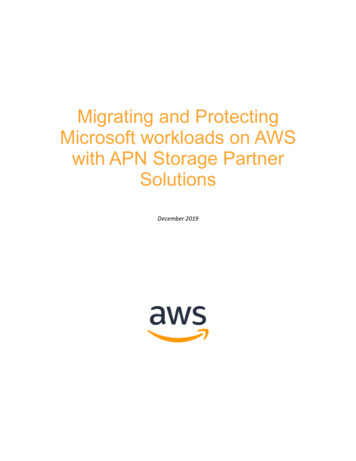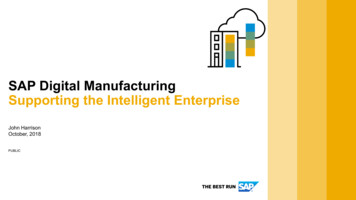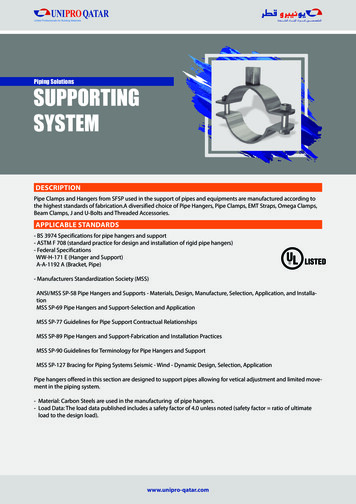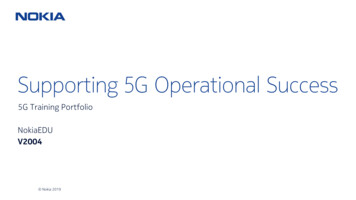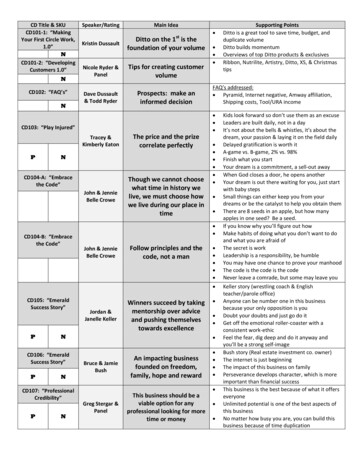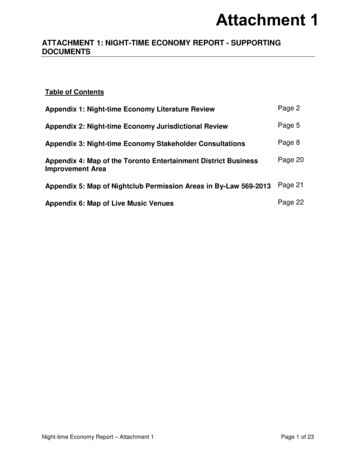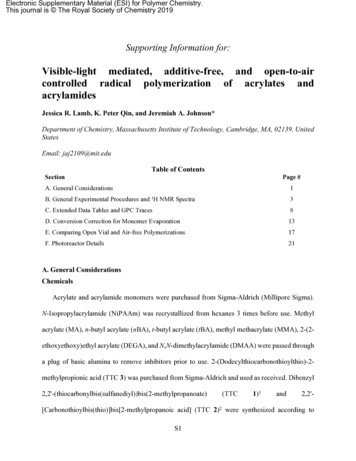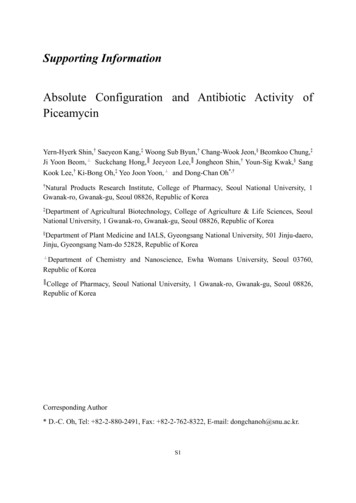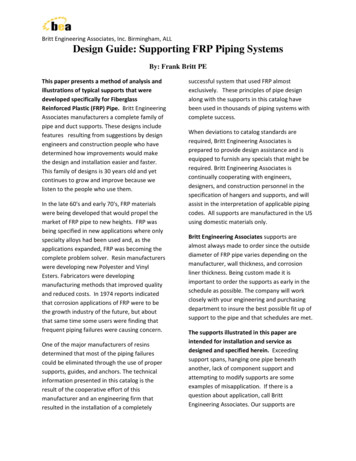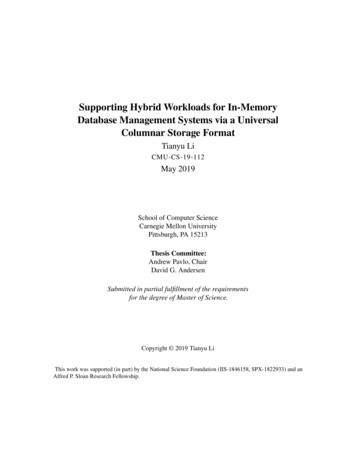
Transcription
Supporting Hybrid Workloads for In-MemoryDatabase Management Systems via a UniversalColumnar Storage FormatTianyu LiCMU-CS-19-112May 2019School of Computer ScienceCarnegie Mellon UniversityPittsburgh, PA 15213Thesis Committee:Andrew Pavlo, ChairDavid G. AndersenSubmitted in partial fulfillment of the requirementsfor the degree of Master of Science.Copyright 2019 Tianyu LiThis work was supported (in part) by the National Science Foundation (IIS-1846158, SPX-1822933) and anAlfred P. Sloan Research Fellowship.
Keywords: Database Systems, Apache Arrow
AbstractThe proliferation of modern data processing ecosystems has given rise toopen-source columnar data formats. The key advantage of these formats isthat they allow organizations to load data from database management systems(DBMSs) once instead of having to convert it to a new format for each usage.These formats, however, are read-only. This means that organizations muststill use a heavy-weight transformation process to load data from their originalformat into the desired columnar format. We aim to reduce or even eliminatethis process by developing an in-memory storage management architecturefor transactional DBMSs that is aware of the eventual usage of its data andoperates directly on columnar storage blocks. We introduce relaxations tocommon analytical format requirements to efficiently update data, and relyon a lightweight in-memory transformation process to convert blocks back toanalytical forms when they are cold. We also describe how to directly accessdata from third-party analytical tools with minimal serialization overhead. Toevaluate our work, we implemented our storage engine based on the ApacheArrow format and integrated it into the CMDB DBMS. Our experiments showthat our approach achieves comparable performance with dedicated OLTPDBMSs while also enabling orders of magnitude faster data exports to externaldata science and machine learning libraries than existing approaches.
iv
AcknowledgmentsI would like to thank my advisor, Professor Andy Pavlo for help and guidance in this work.He introduced me to research and taught me many lessons, both in databases and otherthings that do not belong in an official document. I would also like to thank other studentsand staff in the CMU Database Group that helped in this project: Matt Butrovich, WanShen Lim, Amadou Ngom and Pervaze Akhtar. Thanks to Yuxiang Zhu and Tan Li of CMUfor their help in setting up experiments, and to Professor Dave Andersen for his guidanceand feedback in the network portion of this work. Special thanks to Wes McKinney ofUrsa Labs for his input in the formulation of this work. I would also like the thank otherprofessors and staff of Carnegie Mellon’s School of Computer Science for providing mewith the awesome platform to learn and do research. Last but not least, thanks to Yifei Lifor her support and understanding during this project.v
vi
Contents12345Introduction11.1Motivation for This Research . . . . . . . . . . . . . . . . . . . . . . . .11.2Overview of This Thesis . . . . . . . . . . . . . . . . . . . . . . . . . .2Background52.1Data Movement and Transformation . . . . . . . . . . . . . . . . . . . .52.2Column-Stores and Apache Arrow . . . . . . . . . . . . . . . . . . . . .72.3Hybrid Storage Considered Harmful . . . . . . . . . . . . . . . . . . . .9Related Work113.1Universal Storage Formats . . . . . . . . . . . . . . . . . . . . . . . . .113.2OLTP on Column-Stores . . . . . . . . . . . . . . . . . . . . . . . . . .123.3Optimized DBMS Networking . . . . . . . . . . . . . . . . . . . . . . .13System Overview154.1Transactions on a Column Store . . . . . . . . . . . . . . . . . . . . . .154.2Blocks and Physiological Identifiers . . . . . . . . . . . . . . . . . . . .174.3Garbage Collection . . . . . . . . . . . . . . . . . . . . . . . . . . . . .194.4Logging and Recovery . . . . . . . . . . . . . . . . . . . . . . . . . . .21Block Transformation255.126Relaxed Columnar Format . . . . . . . . . . . . . . . . . . . . . . . . .vii
5.2Identifying a Cold Block . . . . . . . . . . . . . . . . . . . . . . . . . .275.3Transformation Algorithm . . . . . . . . . . . . . . . . . . . . . . . . .295.3.1Phase #1: Compaction . . . . . . . . . . . . . . . . . . . . . . .295.3.2Phase #2: Gathering . . . . . . . . . . . . . . . . . . . . . . . .32Additional Considerations . . . . . . . . . . . . . . . . . . . . . . . . .345.4.1Dictionary Encoding . . . . . . . . . . . . . . . . . . . . . . . .345.4.2Memory Management . . . . . . . . . . . . . . . . . . . . . . .355.467Data Export376.1Improved Wire Protocol for SQL . . . . . . . . . . . . . . . . . . . . . .376.2Alternative Query Interface . . . . . . . . . . . . . . . . . . . . . . . . .386.3Client-Side RDMA . . . . . . . . . . . . . . . . . . . . . . . . . . . . .396.4Server-Side RDMA . . . . . . . . . . . . . . . . . . . . . . . . . . . . .406.5External Tool Execution on the DBMS . . . . . . . . . . . . . . . . . . .40Evaluation437.1OLTP Performance . . . . . . . . . . . . . . . . . . . . . . . . . . . . .437.2Transformation to Arrow . . . . . . . . . . . . . . . . . . . . . . . . . .467.2.1Throughput . . . . . . . . . . . . . . . . . . . . . . . . . . . . .467.2.2Write Amplification . . . . . . . . . . . . . . . . . . . . . . . .507.2.3Sensitivity on Compaction Group Size . . . . . . . . . . . . . . .50Data Export . . . . . . . . . . . . . . . . . . . . . . . . . . . . . . . . .517.38Conclusion and Future Work55Bibliography57viii
List of Figures2.12.22.33.14.14.25.15.25.35.4Data Transformation Costs – Time taken to load a TPC-H table intoPandas with different approaches. . . . . . . . . . . . . . . . . . . . . .7SQL Table to Arrow – An example of using Arrow’s API to describe aSQL table’s schema in a high-level language like Python. . . . . . . . .7Variable Length Values in Arrow – Arrow represents variable lengthvalues as an offsets array into an array of bytes, which trades off efficientmutability for read performance. . . . . . . . . . . . . . . . . . . . . . .9Vectorized PostgreSQL Wire Protocol – Instead of transmitting row-ata-time, a vectorized protocol would transmit column batches. . . . . . .14System Architecture – CMDB’s transactional engine is minimally intrusive to the underlying storage to maintain compatibility with the Arrowstorage format. . . . . . . . . . . . . . . . . . . . . . . . . . . . . . . .18TupleSlot – By aligning blocks to start at 1 MB boundaries, the DBMSpacks the pointer to the block and the offset in a single 64-bit word. . . .20Variable-Length Value Storage – The system uses 16 bytes to trackvariable-length values as a fixed-size column in a block. . . . . . . . . .25Relaxed Columnar Format – The system briefly allows non-contiguousmemory to support efficient mutation of Arrow blocks. . . . . . . . . . .27Transformation to Arrow – CMDB implements a pipeline for lightweightin-memory transformation of cold data to Arrow. . . . . . . . . . . . . .31Check-and-Miss on Block Status – A naïve implementation results in arace within the critical section of the gathering phase. . . . . . . . . . .34ix
6.16.2Client-Side RDMA – An illustration of the message flow between DBMSand client if the DBMS implements client-side RDMA . . . . . . . . . .39Server-Side RDMA – An illustration of the message flow between DBMSand client if the DBMS implements server-side RDMA. As shown, themessage flow involved is much more complex than client-side RDMA. .417.1OLTP Performance: Throughput – Throughput measurements of theDBMS for the TPC-C workload when varying the number of worker threads. 447.2OLTP Performance: Block State Coverage – Block state coverage ofthe DBMS at the end of a TPC-C run when varying the number of workerthreads. . . . . . . . . . . . . . . . . . . . . . . . . . . . . . . . . . . .45Transformation Throughput – Measurements of the DBMS’s transformation algorithm throughput and movement cost when migrating blocksfrom the relaxed format to the canonical Arrow format. . . . . . . . . . .47Transformation Throughput on Alternative Layouts – Measurementsof the DBMS’s transformation algorithm throughput and when varying thelayout of the blocks being transformed. . . . . . . . . . . . . . . . . . .49Write Amplification – Total write amplification is number of tuple movement times a constant for each table, decided by the layout and number ofindexes on that table. . . . . . . . . . . . . . . . . . . . . . . . . . . . .51Sensitivity on Compaction Group Size – Efficacy measurements of thetransformation algorithm when varying the number of blocks per compaction group while processing 500 blocks. The percentage of empty slotsis what portion of each block is empty (i.e., does not contain a tuple). Wemeasure the number of blocks freed during one round. . . . . . . . . . .52Sensitivity on Compaction Group Size – Efficacy measurements of thetransformation algorithm when varying the number of blocks per compaction group while processing 500 blocks. The percentage of empty slotsis what portion of each block is empty (i.e., does not contain a tuple). Wemeasure the average write-set size of transactions in the transformationalgorithm. . . . . . . . . . . . . . . . . . . . . . . . . . . . . . . . . . .53Data Export – Measurements of data export speed of CMDB using different export mechanisms, with varying percentage of blocks treated as hot. . . . . . . . . . . . . . . . . . . . . . . . . . . . . . . . . . . . . . .547.37.47.57.67.77.8x
List of Tablesxi
xii
Chapter 1Introduction1.1Motivation for This ResearchData analysis pipelines allow organizations to extrapolate new insights from data residing intheir on-line transactional processing (OLTP) systems. Tools that make up these pipelinesoften use standard binary formats that grew out of the open-source community, such asApache Parquet [par], Apache ORC [apa [c]] and Apache Arrow [apa [a]]. These formatsare popular because they allow disparate systems to exchange data through a commoninterface without repeated conversion between proprietary formats. They are designed tobe read-only, however, which means that a data scientists needs to use a heavy-weightprocess to export data from the OLTP DBMS into the desired format. This process wastescomputing power and limits both the immediacy and frequency of analytics.Enabling analysis of data as soon as it arrives in a database is an important goal inDBMS implementation. Over the past decade, several companies and research groups havedeveloped hybrid transactional analytical processing (HTAP) DBMSs in attempts to addressthis issue [Pezzini et al. [2014]]. These systems, however, are not one-size-fits-all solutionsto the problem. Modern data science workloads often involve specialized frameworks, suchas TensorFlow, PyTorch, and Pandas. Legacy DBMSs cannot hope to outperform thesetools for workloads such as machine learning. Additionally, the data science community has1
increasingly standardized around Python as a platform for its tools. As such, organizationsare heavily invested in personnel, tooling, and infrastructure for the Python ecosystem. Itis unlikely HTAP DBMSs will overcome these barriers and replace external tools. Wecontend that these tools will co-exist with relational databases for the foreseeable future.To deliver performance gains across the entire data analysis pipeline, our focus should beto improve a DBMS’s interoperability with external tools.To address this challenge, we present a multi-versioned DBMS architecture that supportsOLTP workloads directly on an open-source columnar storage format used by externalanalytical frameworks. We target Apache Arrow, although our approach is applicable toany columnar format. In this paper, we describe how to build a transaction engine within-memory MVCC delta version chains [Neumann et al. [2015], Wu et al. [2017]] on Arrowwithout intrusive changes to the format. We relax Arrow specification constraints to achievegood OLTP performance, and propose a lightweight transformation process to convert colddata back into the canonical Arrow format. We show that our system facilitates fast exportsto external tools by providing direct access to data through a bulk-export RPC layer withno serialization overhead.1.2Overview of This ThesisWe implemented our storage and concurrency control architecture in CMDB [cmu] andevaluated its OLTP performance. Our results show that we achieve good performanceon OLTP workloads operating on the Arrow format. We also implemented new dataexport protocols assuming Arrow storage, and demonstrate that we are able to reduce dataserialization overhead compared to existing DBMS wire protocols.The remainder of this paper is organized as follows. We first present in 2 the motivationfor this work and introduce the Arrow storage format. We then discuss the system’s overallarchitecture in 4, followed by a detailed discussion of the transformation process and howwe modify existing system components to detect cold blocks and perform the transformation2
with little overhead in 5. The mechanism for data export to analytics is discussed in 6. Wepresent our experimental evaluation in 7 and discuss related work in 3.3
4
Chapter 2BackgroundWe now discuss challenges in using data stored in a transactional DBMS for external dataanalysis. We begin by describing how transformation and movement of data to analyticstools are bottlenecks in modern data processing. We then present a popular open-sourceformat used by these tools, Apache Arrow, and show that the requirements of analyticaldata formats are not incompatible with good OLTP performance. Lastly, we argue thatprevious hybrid storage approaches are not optimal in this setting, and that storing data in aformat close to its eventual use is more efficient.2.1Data Movement and TransformationA data processing pipeline consists of (1) a front-end OLTP layer, and (2) multiple analyticallayers. OLTP engines employ the n-ary storage model (i.e., row store) to support efficientoperations on single tuples. In contrast, the analytical layers use the decomposition storagemodel (i.e., column store) to speed up large scans [Abadi et al. [2008], Boncz et al. [2005],Menon et al. [2017], Kersten et al. [2018]]. Because of disparate optimization strategiesfor these two use cases, organizations often implement the pipeline using a combination ofspecialized tools and systems.5
The most salient issue with this bifurcated approach is data transformation betweenlayers. The complexity of modern analytical pipelines have increased with the introductionof new machine learning (ML) workloads. ML tools are data-intensive and not interoperablewith the OLTP system’s format, making loading and preparation of the data from a DBMSexpensive. For example, a data scientist will (1) execute SQL queries to bulk-export thedata from PostgreSQL, (2) load it into a Jupyter notebook on a local machine and prepare itwith Pandas, and (3) train models on cleaned data with TensorFlow. Each step in such apipeline transforms data into a format native to the target framework: a disk-optimized rowstore for PostgreSQL, Pandas Dataframes for Pandas, and finally tensors for TensorFlow.The slowest by far is from the DBMS to Pandas. The data scientist first retrieves the dataover the DBMS’s network protocol, and then decomposes the data into the desired columnarformat. This process is not optimal for high-bandwidth data movement [Raasveldt andMühleisen [2017]].To better understand this issue, we measured the time it takes to extract data fromPostgreSQL (v10.6) and load it into an external Pandas program. We use the LINEITEMtable from TPC-H with scale factor 10 (60M tuples, 8 GB as a CSV file, 11 GB as aPostgreSQL table). We compare three approaches for loading the table into the Pythonprogram: (1) SQL over a Python ODBC connection, (2) using PostgreSQL’s COPY commandto export a CSV file to disk and then loading it into Pandas, and (3) loading data directlyfrom a buffer already in the Python runtime’s memory. The last method represents thetheoretical best-case scenario to provide us with an upper bound for data export speed. Wepre-load the entire table into PostgreSQL’s buffer pool using the pg warm extension. Tosimplify our setup, we run the Python program on the same machine as the DBMS. Weuse a machine with 132 GB of memory, of which 15 GB are reserved for PostgreSQL’sshared buffers so that there is more than enough space to store a copy of the table bothin the DBMS’s buffer pool and in the Python script. We provide a full description of ouroperating environment for this experiment in 7.The results in 2.1 show that Python ODBC and CSV are orders of magnitude slowerthan localized access. This is because of the overhead of transforming to a different format,as well as excessive serialization in the PostgreSQL wire protocol, where query processing6
Load Time SV ExportCSV LoadPostgreSQL Query ProcessingPostgreSQL Export284.468.38In-MemoryCSVPostgreSQLFigure 2.1: Data Transformation Costs – Time taken to load a TPC-H table into Pandas withdifferent approaches.CREATE TABLE item (i id INT NOT NULL,i name VARCHAR(24) NOT NULL,i price DECIMAL(5,2) NOT NULL,i data VARCHAR(50) NOT NULL,i im id INT NOT NULL,PRIMARY KEY (i id));import pyarrow as paitem pa.schema([('i id', pa.int32()),('i name', pa.string()),('i price', pa.decimal(5, 2)),('i data', pa.string()),('i im id', pa.int32())])Figure 2.2: SQL Table to Arrow – An example of using Arrow’s API to describe a SQL table’sschema in a high-level language like Python.itself takes 0.004% of the total export time. The rest of time is spent in the serializationlayer and in transforming the data. Optimizing this data export process can greatly speedup the entire analytics pipeline.2.2Column-Stores and Apache ArrowThe inefficiency of loading data through a SQL interface requires us to rethink the dataexport process. If the OLTP DBMS and these external tools operate on the same format,7
the data export cost is reduced to just the cost of network transmission. But as discussedpreviously, OLTP DBMSs are row-stores because the conventional wisdom is that columnstores are inferior for OLTP workloads. Recent work [Neumann et al. [2015], Sikka et al.[2012]], however, has shown that column-stores can support high-performance transactionalprocessing. We therefore propose to implement a high-performance OLTP DBMS directlyon top of a format used by analytics tools. To do so, we identify a representative format,Apache Arrow, and analyze its strengths and weaknesses on OLTP workloads.Apache Arrow is a cross-language development platform for in-memory data. Itwas conceived when groups of developers from Apache Drill, Apache Impala, ApacheKudu, Pandas, and others independently explored universal in-memory columnar dataformats. These groups then joined together in 2015 to develop a shared format basedon their overlapping requirements. Arrow was introduced in 2016 and has since becomethe standard for columnar in-memory analytics as a high-performance interface betweenheterogeneous systems. There is a growing ecosystem of tools built for Arrow, includingbindings for several programming languages, computational libraries, and IPC frameworks.At the core of Arrow is a columnar memory format for flat and hierarchical data.This format enables (1) fast analytical data processing by optimizing for data localityand vectorized execution and (2) zero-deserialization data interchange between disparatesoftware systems. To achieve the former, Arrow organizes data contiguously in 8-bytealigned buffers and uses separate bitmaps to track nulls. For the latter, Arrow specifies astandard in-memory representation and provides a C-like data definition language (DDL)for communicating metadata about a data schema. Arrow uses separate metadata datastructures to impose
open-source columnar data formats. The key advantage of these formats is that they allow organizations to load data from database management systems (DBMSs) once instead of having to convert it to a new format for each u
